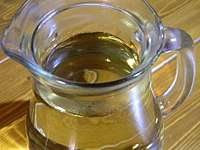Corn tea
Oksusu-cha (옥수수차) or corn tea is a Korean tea made from corn.[1] While oksusu-suyeom-cha (옥수수수염차) or corn silk tea refers to the tea made from corn silk, oksusu-cha can be made from corn kernels, corn silk, or a combination of both.[2] The caffeine-free infusion is a popular hot drink in winter.[1] Along with bori-cha (barley tea), oksusu-cha is one of the free grain teas served in many restaurants in place of water.[3]
| Corn tea | |
|---|---|
 | |
| Type | Herbal tea |
| Other names | Oksusu-cha |
| Origin | Korea |
| Quick description | Tea made from roasted corn kernels |
| Temperature | 100 °C (212 °F) |
| Time | 5‒10 minutes |
| Korean name | |
| Hangul | 옥수수차 |
|---|---|
| Hanja | 玉蜀黍茶 |
| Revised Romanization | oksusu-cha |
| McCune–Reischauer | oksusu-ch'a |
| IPA | [ok.s͈u.su.tɕʰa] |
| Corn silk tea | |
| Hangul | 옥수수수염차 |
| Hanja | 玉蜀黍—-茶 |
| Revised Romanization | oksusu-suyeom-cha |
| McCune–Reischauer | oksusu-suyŏm-ch'a |
| IPA | [ok.s͈u.su.su.jʌm.tɕʰa] |
In Gangwon Province, the tea is called gangnaengi-cha (강냉이차)—gangnaengi is a Gangwon dialect for "corn"—and is consumed throughout late autumn and winter in most households.[4]
Preparation
Traditionally, corn kernels are dried and roasted to prepare oksusu-cha.[2] The roasted corn kernels are then boiled in water until the tea turns yellow.[4] The tea is then strained and the boiled corn discarded. Although the drink is naturally sweet, sugar is sometimes added when a sweeter flavor is desired.[4]
Roasted corn kernels are available at groceries, traditional markets and supermarkets in Korea, as well as at Korean groceries abroad. Tea bags containing ground corn are also commercially available.[5]
Blends
Oksusu-cha is often combined with bori-cha (barley tea), as the corn's sweetness offsets the slightly bitter flavor of the barley.
Gallery
 Jasaek-oksusu-cha (purple corn tea) tea bag
Jasaek-oksusu-cha (purple corn tea) tea bag Roasted corn kernels
Roasted corn kernels Boiling roasted corn kernels
Boiling roasted corn kernels
See also
References
- Lee, J. (4 January 2016). "5 winter warmers that are caffeine-free". Christian Today. Retrieved 23 August 2017.
- Jung, Alex (13 July 2017). "Best Korean drinks -- from banana milk to hangover juice". CNN Travel. Retrieved 23 August 2017.
- Kayal, Michele (28 July 2015). "Seoul food: Fueled by heat-seeking Americans, Korean cuisine is hot, hot, hot". Santa Cruz Sentinel. Retrieved 23 August 2017.
- "Gangnaengi-cha" 강냉이차. Doopedia (in Korean). Doosan Corporation. Retrieved 23 August 2017.
- 장, 박원 (13 February 2001). "샘표식품, 우리보리차.옥수수차 시판". Maeil Business Newspaper (in Korean). Retrieved 30 June 2010 – via Naver.